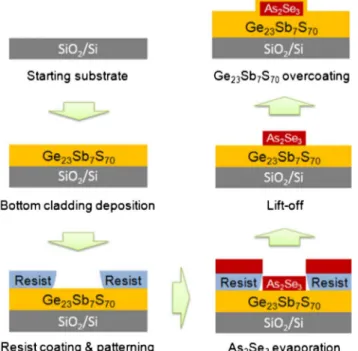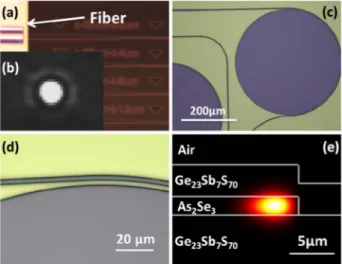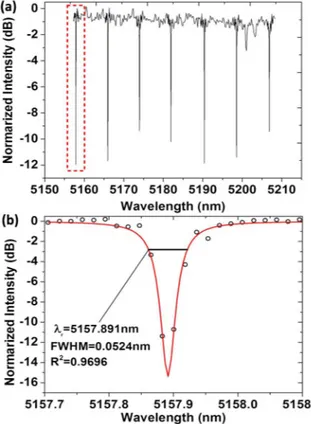Demonstration of high-Q mid-infrared
chalcogenide glass-on-silicon resonators
The MIT Faculty has made this article openly available.
Please share
how this access benefits you. Your story matters.
Citation
Lin, Hongtao et al. “Demonstration of high-Q Mid-infrared
Chalcogenide Glass-on-silicon Resonators.” Optics Letters 38.9
(2013): 1470. © 2013 Optical Society of America
As Published
http://dx.doi.org/10.1364/OL.38.001470
Publisher
Optical Society of America
Version
Final published version
Citable link
http://hdl.handle.net/1721.1/79737
Terms of Use
Article is made available in accordance with the publisher's
policy and may be subject to US copyright law. Please refer to the
publisher's site for terms of use.
Demonstration of high-
Q mid-infrared chalcogenide
glass-on-silicon resonators
Hongtao Lin,1Lan Li,1Yi Zou,1Sylvain Danto,2J. David Musgraves,2Kathleen Richardson,2
Stephen Kozacik,3Maciej Murakowski,3Dennis Prather,3Pao T. Lin,4Vivek Singh,4
Anu Agarwal,4Lionel C. Kimerling,4and Juejun Hu1,*
1Department of Materials Science and Engineering, University of Delaware, Newark, Delaware 19716, USA
2College of Optics & Photonics, Department of Materials Science and Engineering, University of Central Florida, Orlando, Florida 32816, USA 3Department of Electrical and Computer Engineering, University of Delaware, Newark, Delaware 19716, USA
4Department of Materials Science and Engineering, Massachusetts Institute of Technology, Cambridge, Massachusetts 02139, USA
*Corresponding author: hujuejun@udel.edu
Received February 20, 2013; revised March 18, 2013; accepted March 26, 2013; posted March 27, 2013 (Doc. ID 185670); published April 26, 2013
We demonstrated high-index-contrast, waveguide-coupled As2Se3 chalcogenide glass resonators monolithically integrated on silicon fabricated using optical lithography and a lift-off process. The resonators exhibited a high intrinsic quality factor of2 × 105 at 5.2μm wavelength, which is among the highest values reported in on-chip mid-infrared (mid-IR) photonic devices. The resonator can serve as a key building block for mid-IR planar photonic circuits. © 2013 Optical Society of America
OCIS codes: (230.5750) Resonators; (130.3060) Infrared; (130.3120) Integrated optics devices.
http://dx.doi.org/10.1364/OL.38.001470
Owing to their strong optical confinement and long cavity photon lifetime, planar photonic resonators are recognized as key components for mid-infrared
(mid-IR, 3–20 μm) applications, including spectroscopic
sens-ing, free space communications, and thermal imaging [1].
Since silica becomes opaque at wavelengths longer than
3.5 μm, mid-IR integrated resonators demonstrated to
date either involve special suspended designs [2–4] or
new material platforms, such as silicon-on-sapphire [5,6]. Quality factors measured in these devices range from
3000 to2.8 × 105. However, bound by the onset of phonon
absorption in crystalline silicon, the optical transparency
window of these devices extends only up to 7 μm
wavelength.
Alternatively, chalcogenide glasses (ChGs), namely the amorphous compounds containing S, Se, and/or Te, have been recognized as a material of choice for IR ap-plications given their wide optical transparency window
in the mid-IR [7]. Besides their excellent mid-IR
transpar-ency, ChGs possess low thermal conductivity (<1 W∕mK,
large thermo-optic coefficients (>10−4∕K), and hence a
photothermal figure-of-merit>300 times higher than
sil-icon, making them ideal material candidates for on-chip photothermal detection down to single chemical
mol-ecule levels [8,9]. ChG mid-IR waveguides have been
fabricated on silicon using photosensitive writing [10]
and on exotic substrates, such as As2S3 glass [11], NaCl
[12,13], and LiNbO3 [14]. However, mid-IR ChG
resona-tors have not yet been demonstrated.
In this Letter, we report for the first time ChG mid-IR resonators monolithically fabricated on a silicon
plat-form by optical lithography. We chose As2Se3over more
commonly used sulfide ChGs given its high refractive
index (n ∼ 2.66 the mid-IR) [15] and reduced phonon
en-ergy, which gives rise to a long wavelength absorption
onset up to 14 μm. The devices were tested by fiber
end fire coupling using a quantum cascade laser (QCL)
at 5.2 μm mid-IR wavelength.
Figure1schematically illustrates the fabrication
proc-ess of the ChG mid-IR waveguide-coupled resonators, which was carried out at the Nanofabrication Facility at the University of Delaware. The devices were
fabri-cated on300 silicon wafers topped with 300 nm thermal
oxide (from University Wafer) as the starting substrate. To prevent absorption of silica (extinction coefficient
k ∼ 5.49 × 10−3 at 5.2 μm [16]) and optical leakage into
the silicon substrate, a 3 μm thick mid-IR transparent
(up to 12 μm wavelength) and relatively low refractive
index (n ∼ 2.1) Ge23Sb7S70glass film [17] was first depos-ited as the bottom cladding. Details of the glass synthesis
Fig. 1. Schematic fabrication process flow for the As2Se3 mid-IR waveguides (not drawn to scale).
1470 OPTICS LETTERS / Vol. 38, No. 9 / May 1, 2013
and deposition processes can be found in [18,19]. Reversed patterns in a negative tone photoresist (NR9-1500PY, Futurrex Inc.) were defined using contact
lithog-raphy on an ABM Mask Aligner, and a 1.1μm thick As2Se3
film was subsequently deposited as the waveguide core layer. The entire structure was then sonicated in acetone to dissolve the resist layer beneath the undesired parts of the As2Se3film, leaving an As2Se3pattern reverse to that of the photoresist. As a final step, a 2μm thick Ge23Sb7S70
overcoating layer was deposited on top of the As2Se3
core to prevent surface oxidation and formation of large AsOx crystallites [20]. To facilitate optical coupling into and out of the bus waveguides, the processed wafers were subsequently cleaved to form end facets.
Mid-IR transmission characteristics of the resonators were measured using a fiber end fire coupling method.
Figure 2 illustrates a schematic diagram of the mid-IR
measurement setup. In our measurements, a CaF2 lens
(NA∼ 0.25) was used to couple TE-polarized mid-IR light
from a 5.2 μm external cavity tunable QCL (Daylight
Solution, Inc.) into a customized InF3 fiber (IRPhotonics
Inc.). Since the optical fiber is multimode at the 5.2μm
wavelength (core/cladding diameters40∕150 μm), careful
optimization of the laser-fiber alignment was performed to minimize excitation of high-order fiber modes. The
mid-IR light was butt-coupled to the planar As2Se3 bus
waveguides through the optical fiber [Fig.3(a)], and
op-tical output at the waveguide end facet was collected by
another CaF2 lens and imaged in the far field using a
liquid nitrogen cooled InSb focal plane array (FPA). To minimize thermal radiation noise from the ambient background, a liquid nitrogen cooled bandpass filter
centered at 5.2μm wavelength was inserted in the optical
path.
Subwavelength waveguide core dimensions (width
2.5μm and height 1.1 μm) are necessary for single-mode
operation and efficient coupling into the resonator
given the high refractive index of As2Se3. As is shown
in Fig. 3(a), an adiabatic lateral taper section was
in-serted near the bus waveguide input facet to minimize coupling loss due to mode mismatch between the input fiber and the single-mode bus waveguide. A lateral offset of 5 mm between the input and output facets of the wave-guides was added to prevent interference of the guided mode with stray free-space light directly from the laser.
A far-field image of the guided mode from a 2.5μm wide
single-mode As2Se3bus waveguide is shown in Fig.3(b).
The transmitted intensity was measured by integrating the number of counts on FPA pixels over the waveguide mode image, after subtraction of the thermal background contribution.
Figure 3(c) shows the top view of a 200 μm radius
pulley-coupled As2Se3 mid-IR microdisk resonator. The
gap width between the disk and the single-mode bus
waveguide is set to 2.75μm to attain near-critical coupling
operation [Fig.3(d)]. Compared to the conventional
cou-pler configuration, the pulley coucou-pler design improves the fabrication tolerance by increasing the coupling strength
[21,22]. Figure 4(a) shows the TE polarization
trans-mission spectrum of the resonator. The group index cal-culated from the free spectral range (experimentally
mea-sured FSR∼ 8.16 nm) is 2.63, which is close to our finite
difference simulation result (2.68) assuming a
fundamen-tal transverse whispering gallery mode order [Fig.3(e)] of
the disk resonator. LoadedQ factors, measured from 22
resonant peaks in three different samples, range from6 ×
104to105. Figure4(b)shows the spectrum measured from
the highestQ device near its resonance peak at 5157.9 nm
wavelength. A loadedQ factor of 105 was inferred from
the spectrum, corresponding to an intrinsic Q factor of
2 × 105 and an equivalent waveguide propagation loss of
0.7 dB∕cm. This Q factor is among the highest values re-ported in experimentally demonstrated mid-IR resonators. We further performed full vectorial finite difference
simulations [23] to quantify the optical loss mechanisms
in the resonator. Figure 3(e) shows the calculated
fundamental quasi-TE whispering gallery mode profile.
The simulation indicates negligible optical loss
(<0.01 dB∕cm) due to silica absorption, substrate
leak-age, and radiative bending loss. We consequently con-clude that the loss must primarily result from either material absorption or sidewall roughness scattering. It is likely that excess surface roughness at the interface between the core and the top cladding layer accounts
for the observed 0.7 dB∕cm optical loss. Improvement
of the resonator performance is thus expected through further processing optimization, or via adoption of
Fig. 2. Mid-IR fiber end fire waveguide measurement setup schematic.
Fig. 3. (a) Top-view microscope image of a mid-IR InF3fiber end-coupled to an As2Se3waveguide with a lateral taper to re-duce the mode mismatch; (b) far-field image of the TE-guided mode from a single-mode As2Se3bus waveguide; (c) optical mi-croscope top-view image of a 200μm radius mid-IR resonator; (d) microscope image showing the 2.75μm wide coupling gap between the bus waveguide and the microdisk resonator; and (e) simulated field intensity profile of the fundamental whisper-ing gallery mode of the ChG microdisk resonator.
fine-line patterning methods, such as electron beam lithography.
In conclusion, we have demonstrated for the first time ChG mid-IR microresonators monolithically integrated
on silicon. We measured an intrinsicQ factor of 2 × 105
at 5.2 μm wavelength, which corresponds to a low
propagation loss of 0.7 dB∕cm. The high-Q ChG mid-IR
resonator offers a promising device platform for mid-IR integrated photonics.
The authors gratefully acknowledge support from the National Science Foundation under award number 1200406 and EPSCoR grant EPS-0814251. Additional par-tial support has been provided by the U.S. Department of Energy [Contract No. DE-NA000421], NNSA/DNN R&D. This Letter has been prepared as an account of work partially supported by an agency of the United States Government. Neither the United States Government nor any agency thereof, nor any of their employees, makes any warranty, express or implied, or assumes any legal liability or responsibility for the accuracy, com-pleteness or usefulness of any information, apparatus,
product or process disclosed, or represents that its use would not infringe privately owned rights. Reference herein to any specific commercial product, process, or service by trade name, trademark, manufacturer, or otherwise does not necessarily constitute or imply its endorsement, recommendation, or favoring by the United States Government or any agency thereof. The views and opinions of authors expressed herein do not necessarily state or reflect those of the United States Government or any agency thereof.
References
1. R. A. Soref, Proc. SPIE6898, 689809 (2008).
2. R. Shankar, R. Leijssen, I. Bulu, and M. Loncar, Opt. Express19, 5579 (2011).
3. R. Shankar, I. Bulu, R. Leijssen, and M. Loncar, Opt. Express19, 24828 (2011).
4. Z. Cheng, X. Chen, C. Y. Wong, K. Xu, and H. K. Tsang, IEEE Photonics J.4, 1510 (2012).
5. A. Spott, Y. Liu, T. Baehr-Jones, R. Ilic, and M. Hochberg, Appl. Phys. Lett.97, 213501 (2010).
6. R. Shankar, I. Bulu, and M. Loncar, Appl. Phys. Lett.102, 051108 (2013).
7. A. B. Seddon, J. Non-Cryst. Solids184, 44 (1995). 8. J. J. Hu, Opt. Express18, 22174 (2010).
9. H. T. Lin, Z. Yi, and J. J. Hu, Opt. Lett.37, 1304 (2012). 10. N. Ho, M. C. Phillips, H. Qiao, P. J. Allen, K. Krishnaswami,
B. J. Riley, T. L. Myers, and N. C. Anheier, Opt. Lett.31, 1860 (2006).
11. C. Vigreux-Bercovici, E. Bonhomme, A. Pradel, J. E. Broquin, L. Labadie, and P. Kern, Appl. Phys. Lett. 90, 011110 (2007).
12. C. Tsay, E. Mujagic, C. K. Madsen, C. F. Gmachl, and C. B. Arnold, Opt. Express18, 15523 (2010).
13. C. Tsay, Y. Zha, and C. B. Arnold, Opt. Express18, 26744 (2010).
14. X. Xia, Q. Chen, C. Tsay, C. B. Arnold, and C. K. Madsen, Opt. Lett.35, 3228 (2010).
15. N. Carlie, J. N. C. Anheier, H. A. Qiao, B. Bernacki, M. C. Phillips, L. Petit, J. D. Musgraves, and K. Richardson, Rev. Sci. Instrum.82, 053103 (2011).
16. E. D. Palik, Handbook of Optical Constants of Solids (Elsevier, 1997).
17. J. D. Musgraves, N. Carlie, J. Hu, L. Petit, A. Agarwal, L. C. Kimerling, and K. A. Richardson, Acta Mater. 59, 5032 (2011).
18. L. Petit, N. Carlie, F. Adamietz, M. Couzi, V. Rodriguez, and K. C. Richardson, Mater. Chem. Phys.97, 64 (2006). 19. J. J. Hu, V. Tarasov, A. Agarwal, L. Kimerling, N. Carlie, L.
Petit, and K. Richardson, Opt. Express15, 2307 (2007). 20. Y. Zou, H. Lin, O. Ogbuu, L. Li, S. Danto, S. Novak, J. Novak,
J. D. Musgraves, K. Richardson, and J. Hu, Opt. Mater. Express2, 1723 (2012).
21. J. J. Hu, N. Carlie, N. N. Feng, L. Petit, A. Agarwal, K. Richardson, and L. Kimerling, Opt. Lett.33, 2500 (2008). 22. E. S. Hosseini, S. Yegnanarayanan, A. H. Atabaki, M. Soltani,
and A. Adibi, Opt. Express18, 2127 (2010).
23. Photon Design Ltd., “http://www.photond.com/products/ fimmwave.htm, retrieved.
Fig. 4. (a) Mid-IR optical transmission spectrum of the As2Se3 microdisk resonator measured using a wavelength sweeping method and (b) spectrum near the optical resonance at 5157.89 nm wavelength (the red box in a). The dots are exper-imentally measured data and the line is the linear-scale Lorent-zian fit, which indicates a loaded cavity quality factor of105. 1472 OPTICS LETTERS / Vol. 38, No. 9 / May 1, 2013


